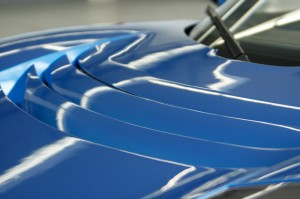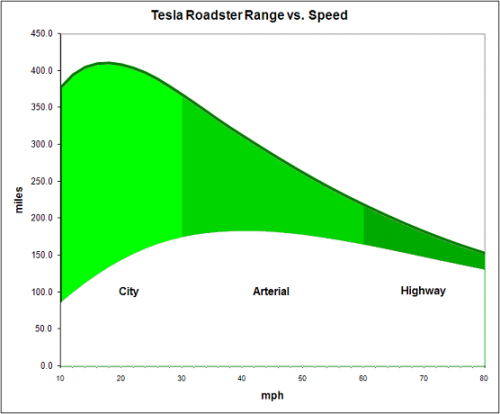When you climb into the seat of a high-performance car, you expect certain things:
- acceleration that pushes you back into the seat
- top-end stereo equipment
- road-hugging handling
- the throaty roar of a powerful engine
- a big budget for the high-octane gas needed to fuel it
The Tesla Roadster has almost all of those aspects covered. It’s fast, fancy, handles like a dream and goes like a rocket, but it’s virtually silent and it’ll never burn a single drop of gasoline. Tesla’s first production car is also the world’s first high-performance electric car.
hot topics
For 30 months I was asked all over about 3 hot topics:
- costs (comparison)
- range (reality check)
- charging (network)
costs ( per year, comprehensive coverage Tesla vs. Porsche 911 )
- purchase price virtually identical, small advantage for Tesla
- service costs savings: approx. CHF 800.–
- gas savings: approx. CHF 3’500.– (at 9.0l/100km, 22’000km/year)
- traffic tax savings: approx. CHF 650.– for Zurich
- insurance premium savings: approx. CHF 1’000.–
- electricity costs for Tesla: approx. CHF 500.–
∑ of savings: approx. CHF 5’950.–, which is quit significant.
The long-term maintenance of value for Tesla vs. Porsche 911 is at the least double, but in favor of Tesla Roadster.
range ( how far can you really go? )
A topic explaining to people, that probably keeps EV drivers busy, until battery technologies on the one hand and a stronger network of charging points on the other hand have improved significantly. The convenience gap of filling up the car in 5 minutes at the gas pump vs. range / charging time is still too far apart until no one even talks about it.
Now, lets have a look at how far you can go with a Tesla Roadster vs. the speed or driving habits by getting a closer look at the following chart.
on flat topography w/ accessories
The fat green line marks an ideal range, that is realistic, according to my 30 months experience, when a moderate and preferably steady driving style is guaranteed. The lower edge of the colored area is also realistic when we consume power for i.e. cabin heating or extensive cooling, while at the same time road and environmental conditions (rain, snow, bumpy roads, etc.) do have sensible impact on the actual range. When we are on the road for a longer time, because of lower speed, the gap to ideal range widens.
on ascending slope
Driving upwards has in my view the biggest impact on the range, which the above chart does not cover. Still driving w/ a moderate speed, to surmount an elevation of 100 m reduces the range of roughly 10 km, and this is a lot. A steady climb of 10% (nothing extraordinary for Switzerland) on a slop of 10 km is reducing your range approximately by 110 km. The good news is for most cases, that in between this distance roads also do have downhill legs, where recuperation kicks in.
Nevertheless, when I am planning my long distance trips ( >=400 km ), I’d rather choose longer slops than steeper ones.
Summary:
- The Tesla Roadster is among the first all electric cars, breaking the barrier of previous EV’s w/ a maximum range of approximately 150 km, allowing more convenient and faster long distance trips, but still w/ a great deal of planning.
- The above chart is a good indicator on how far you can go when slops are virtually flat and accessories are switched-off or on.
- The impact of ascending slopes outshines by far every other added accessory and in a very short driving time.
charging ( locations, network, available power )
The improved range of the Tesla Roadster allows a whole new strategy for a network, that consists of charging points
- in metropolis
- a view at services near motorways
- at home
- at hotels/resorts
- at the office
- at private Tesla owners
In close to 90% of all cases they are good enough to guarantee easy trips.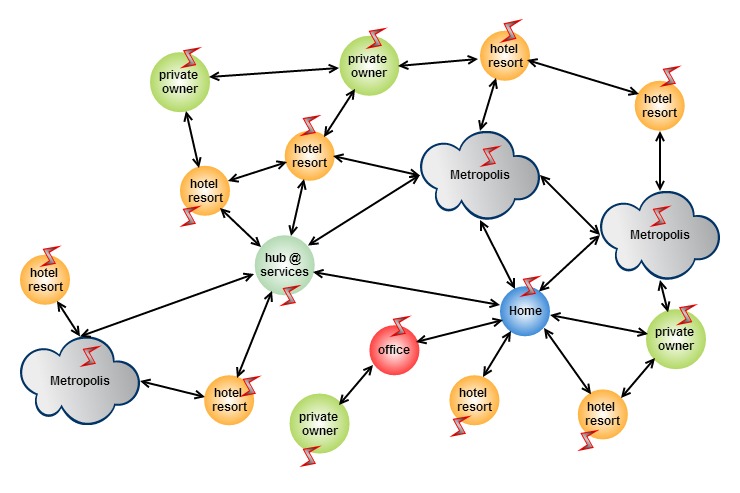
In all of those places, power is already available. Furthermore, there are additional charging points available to complement close to 100% coverage, at
- solar companies and other industries
- Tesla Motors service centers
With a view exceptions these are all private funded charging points and more or less still free of charge. Trips within Switzerland and as far as up to Scotland and Wales using such a network, has been proven correct. Thanks to many Tesla owners and especially to the Zero Carbon World founded by Kevin Sharpe, whose organization did exceptionally well in building the ZeroNet network for Britain.
The Roadster offers a wide range of Amps to charge the battery, that is from 10 Amps up to 70 Amps, the so called HPC’s or High Power Connectors. So basically every ordinary plug socket in households do the job. Power values are adjustable through the cars touch-pad and the approximate charging times to fill-up the battery are listed below:
- 10 Amps = 24 hours
- 13 Amps = 20 hours
- 16 Amps = 16 hours
- 32 Amps = 8 hours
- 56 Amps = 5 hours
- 64 Amps = 4 hours
- 70 Amps = 3.5 hours
From my own experience, it is fair to say, that whenever possible, charging in standard mode ( 90% of full capacity ) should be used. Charging in range mode should be the exception. Other owners made the experience, that charging in performance mode ( so called fast charging ) shows a dramatically reduced life expectancy. Driving the Roadster until the last drop of capacity has its impact on the battery as well.
Driving costs will increase with faster driving and bursting up speed all the time.
Summary:
- Because the Tesla Roadster is laid-out for an improved range, a new perception how a network looks like comes into play, favoring home charging and private funded charging points.
- The Tesla Roadster allows charging up to 70 Amps and w/ 230 V only, a fact that allows 3 Roadsters being charged at once on the alternating current network.
- Driving and in particular charging behavior apparently impacts charging costs and battery lifetime.
how it works
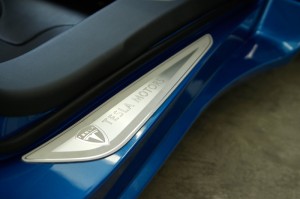 The Roadster is powered by just 4 main systems:
The Roadster is powered by just 4 main systems:
- energy storage system ( ESS )
- power electronics module ( PEM )
- electric motor
- regenerative braking
energy storage system
Certainly the component within the Roadster, that gives room for improvement concerning density, weight, recycling and cost.
Lithium-Ion battery cells, a decade long proven technology in laptops, the single source of energy available in the car and located in the rear end of the car, is THE crucial component. 6’831 cells fitted into 11 sectors à 621 cells, weighing half a tone w/ a total capacity of 56 kWh. Controlled by a computer processor, assuring that all of the charging and discharging is handled smoothly, the battery pack, instead of a conventional combustion engine, is the lifeline of the car.
power electronics module
The PEM converts the DC power supplied by the Lithum-Ion batteries into AC power the electric motor consumes. It hosts i.e.
- 72 Insulated Gate Pipolar Transistors (IGPT’s), that is a fairly recent invention and at present one of the most widely used three-terminal semiconductor devices. In newer devices it is noted for combining high efficiency and extremely fast switching. Not only electric vehicles, but also hybrid cars are equipped with such reliable devices. Under peak acceleration, batteries pump through up to 200kW of energy to the electric motor.
- controlling of the motor’s revolutions per minute ( RPM )
- torque control
- the regenerative braking system, widely known as recuperation.
The efficiency of the integration of the battery, PEM and the motor systems is between 85% and 95%, allowing the motor to put out up to 185 kW of power.
electric motor
The heart of the Tesla Roadster is its AC 3-phase induction motor, weighing just about 50 kg and has the size of a water melon.
The Roadster’s performance isn’t just acceleration and speed. Unlike combustion engines, the huge advantage of the electric motor is the torque. The Roadster generates large amount of torque even under very low revolutions per minute and always turns out major horsepower.
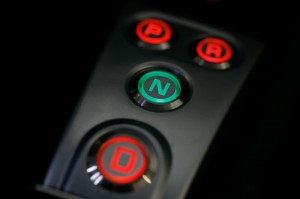
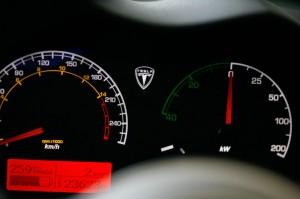 For the Tesla Roadster, the maximum revolutions per minute is 14’000 at a maximum speed of 210km/h.
For the Tesla Roadster, the maximum revolutions per minute is 14’000 at a maximum speed of 210km/h.
No complicated transmission is needed, as with automatic cars, the Tesla Roadster has P=parking, N=neutral, D=drive and R=reverse gear positions. When selecting the reverse gear the current that flows through the Tesla coils is just reversed, triggering the coils to turn around the pols the other way round.
regenerative braking
regenerative braking system collects the kinetic energy, that usually gets lost in the form of heat when the driver hits the brakes, converts it into electricity and then is used to recharge the Tesla Roadster batteries.
In details, the electric motor is put into reverse mode, causing it to actually run backwards, thus slowing the wheels of the car. The motor acts as an electric generator, producing energy that is then fed into the batteries.
technical data
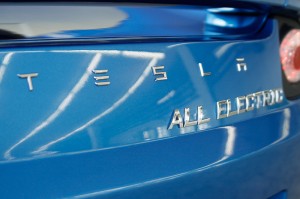
Some information about my own Tesla Roadster
- label : Tesla Roadster 2.5
- date of issue : September 2011
- distance driven : 54’000 km ( End of February 2014 )
- drive concept : battery electric vehicle
- length / width / height : 3.9 m / 1.8 m / 1.2 m
- empty weight : 1’235 kg
- motor type : 3-phase induction motor, ventilated and fluctuating frequency controlled
- performance : 215 kW ( 288 HP )
- maximum torque : 370 Nm
- efficiency : 92%
- acceleration from 0 – 100 k/h : 3.9 s
- maximum speed : 210 km/h
- revolutions per minute : 14’000 rpm at max. speed
- ideal distance in max. range mode driving : 380 km
- ideal distance in standard mode driving : 340 km
- battery type : Lithium-Ion
- battery energy in total : 56 kWh
- number of single cells : 6’831
- battery weight : 450 kg
- charging at 220 V : 10 A, 13 A, 16 A, 24 A, 32 A, 40 A, 48 A, 56 A, 64 A, 70 A ( manually adjustable, timer scheduled )
- charging modes : storage, standard, range, performance
- charging equipment : home charging point ( via isolation transformer; primary=17 Amps / 400 V, secundary=32 A / 220 V ) and plug socket CEE 32 A
- kilometers traveled / year : 22’000 km
- usage : daily ( average=50 km ); long trips up to 4’500 km in 10 days
- power costs / year : approximately CHF 450.– using night power ( CHF 0.12 / kWh between 8 pm and 7 am )
- energy costs / 100 km : approximately CHF 2.00 for moderate driving in city, arterial and highways
- expected residual capacity at 160’000 km of distance : 80% or 300 km ( guaranteed by Tesla Motors; accurate within Tesla Roadster community )
open vehicle monitoring system
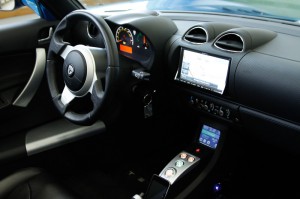 What if the car talks to you and you talk to the car on a phone or a tablet about:
What if the car talks to you and you talk to the car on a phone or a tablet about:
- its battery status ( in % )
- its charging status ( in Km )
- its location ( on google maps )
- temperatures ( PEM, motor, battery )
introduction
situation
Imagine, you gonna meet some friends at a wonderful resort for lunch, while you have plugged in your car at the resort charging point. You want to make sure to have enough range to get back to your office. In the meantime someone else plugged in as well but pulled to much power and the fuse went or some kind of dude just unplugged your car. After an hour and a half you get back to your car and realize that there isn’t enough energy in the battery to make it to your office.
way out
The Open Vehicle Monitoring System ( OVMS ) gives you a warning sign of such a situation, by informing you about the status charging and the battery.
how does it work
The following figure illustrates this with brief details below:
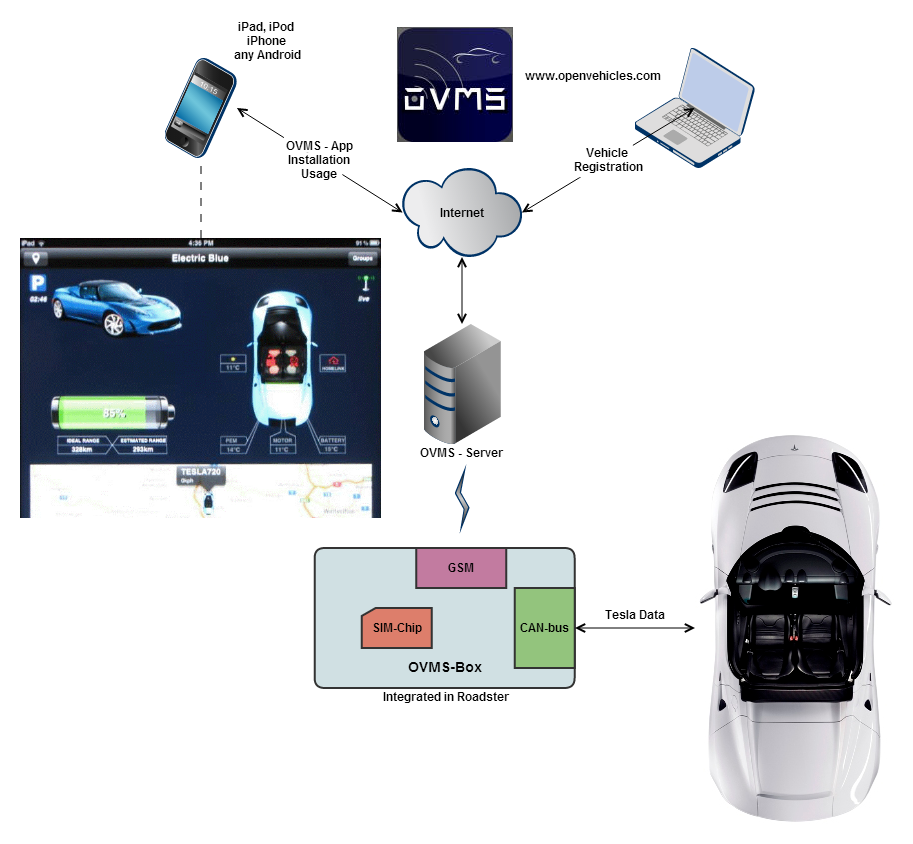 The so called OVMS-box, containing a SIM-Chip ( pre reactivated and unlocked from any pin ), talks to the car, getting all kind of Tesla data out of the CAN-bus ( normally used by the Tesla maintenance team for diagnoses ).
The so called OVMS-box, containing a SIM-Chip ( pre reactivated and unlocked from any pin ), talks to the car, getting all kind of Tesla data out of the CAN-bus ( normally used by the Tesla maintenance team for diagnoses ).
The OVMS-box communicates over GSM ( antenna is placed in the car ) with the OVMS – Server which was previously setup for your vehicle. Data provided by the car can then be viewed on an App that runs either on you iPad, iPhone or any other android phone.
The registration of your vehicle is easily managed via an ordinary PC.

